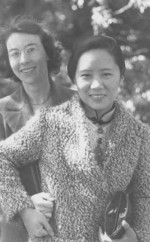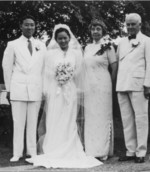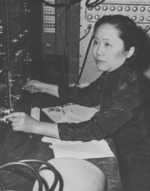Wu Chien-Shiung
| Surname | Wu |
| Given Name | Chien-Shiung |
| Born | 31 May 1912 |
| Died | 16 Feb 1997 |
| Country | China, United States |
| Category | Science-Engineering |
| Gender | Female |
Contributor: C. Peter Chen
ww2dbaseWu Chien-Shiung (Pinyin romanization: Wu Jianxiong) was born in the town of Liuhe in the city of Taicang in Jiangsu Province, China in May 1912 as the second of three children to father Wu Zhongyi, an engineer who had recently participated in the revolution that overthrew the Qing Dynasty on the side of the newly established republic, and mother Fan Fuhua, a teacher. Her father had led a small group of militiamen that guarded against armed Qing sympathizers from entering Liuhe, and also defeated a group of bandits that had attempted to raid the village amidst the political vacuum during the revolution. Both of her parents were supporters of women's equality, and she was given the same educational opportunities as her two brothers. She received her elementary education at the Ming De School, a school for girls founded by her father. In 1923, she enrolled in the Suzhou Women's Normal School No. 2, a boarding school, in Suzhou, Jiangsu Province. In 1929, she graduated at the top of her class. Upon graduation, per Ministry of Education requirements for students graduating with a teaching degree, she had to teach for one year. Having already known the philosopher and political figure Hu Shih, she went to Shanghai to teach at a school that Hu served as the principal. Between 1930 and 1934, she studied at the National Central University in the capital city of Nanjing. As a student studying mathematics and later physics, she was involved in political activism and played leadership roles in several protests. Upon graduation, she did graduate-level study in physics for two years while working as an assistant at Zhejiang University. She then became a researcher at the Institute of Physics of the Academia Sinica, working under female professor Gu Jingwei. Following Gu's footsteps, Wu went to study at the University of Michigan in the United States. She would not realize that as she boarded the SS President Hoover in Shanghai in Aug 1936 for her journey to the United States, it would be the last time she would see her parents due to WW2 and the Chinese Civil War. She traveled with her female friend chemist Dong Ruofen who also aspired to study in Michigan.
ww2dbaseUpon arrival in San Francisco, California, United States, Wu and Dong visited University of California, Berkeley before moving on to Michigan. Having grown up in liberal circles that aspired to the West, she was shocked to find that sexism was rampant at the University of Michigan, where female students were not even allowed to use the front entrance of major campus buildings. Disgusted, she transferred to Berkeley, which had a much more liberal environment. Her friend Dong, however, remained in Michigan. While at Berkeley, she befriended Luke Chia-Liu Yuan, whose paternal grandmother was a concubine of Yuan Shikai, a Chinese leader vilified for briefly overthrowing the young Republic and declaring himself an emperor. Through Yuan, she met physicist Ernest Lawrence, who would later, in 1939, win the Nobel Prize for inventing the cyclotron particle accelerator. Unable to secure a scholarship for her second academic year at Berkeley due to her ethnicity, she transferred to California Institute of Technology ("Caltech"), which offered her a scholarship. At Caltech, she continued to work with Lawrence, while also worked with Italian physicist Emilio Segrè in the area of beta decay. In 1940, she presented her two part thesis. The first part involved beta decay. The second part was about the production of radioactive isotopes of Xe produced by the nuclear fission of uranium, which would pave her way to enter the Manhattan Project. The future head of Manhattan Project, J. Robert Oppenheimer, was in fact a member of her dissertation committee. She was awarded the Doctor of Philosophy degree in Jun 1940. Failing to secure a faculty position, she became a post-doctoral fellow at the Radiation Laboratory (now the Lawrence Berkeley National Laboratory), which was found and headed by Lawrence. In May 1942, she married Yuan at the home of Robert Millikan, the president of Caltech; they would have a son, Vincent Yuan, in 1947. Wu and Yuan moved to the east coast of the United States where Wu became an assistant professor at Smith College in Northampton, Massachusetts while Yuan worked on radar for RCA Corporation. Bored with her teaching position, she appealed for research opportunities, and Smith College responded by promoting her to associate professor and increasing her salary. Still unsatisfied, she accepted a job at Princeton University in New Jersey, becoming that institution's first female faculty member in its physics department.
ww2dbaseWu joined the Manhattan Project in Mar 1944 as a member of Harold Urey's Substitute Alloy Materials (SAM) Laboratories based at Columbia University in New York, New York, United States. Her initial job was to check the radiation effect of the reactor by building her own instruments, a relatively mundane assignment. But when the newly commissioned B Reactor experienced problems, one of the physicists working it it, Emilio Segrè, realized the problem could be related to something Wu had written about in her 1940 dissertation, and recommended Enrico Fermi to reach out to Wu. After some review, Wu's theories regarding Xe-135 did indeed lead Fermi to resolve the problems with B Reactor. With her standing improved, she was also able to contribute to the project in other ways, such the building of a standard model for producing enriched uranium by gaseous diffusion based on her studies on radioactive uranium separation.
ww2dbaseAfter the end of WW2, Wu accepted an offer of a position as an associate research professor at Columbia University, and she would remain at Columbia for the remainder of her career. In 1949, she was able to establish Fermi's 1934 theory on beta decay, thus becoming the leading authority on the subject. She was promoted to associate professor in 1952. In the 1950s, Wu confirmed the parity violation theory proposed by physicists Lee Tsung-Dao and Yang Chenning; though denied a Nobel Prize, she would be awarded the inaugural Wolf Prize for her work in the parity experiments in 1978. In 1958, she became Columbia's first female tenured physics professor. In Dec 1962, she experimentally demonstrated a universal form and more accurate version of Fermi's old beta decay model, confirming the conserved vector current hypothesis of Richard Feynman and Murray Gell-Mann on the road to the Standard Model, using a Van de Graaff accelerator with proton, heavy hydrogen, and helium beams. In 1962, she penned a letter of Chiang Kaishek and offered her recommendation against any effort by the Republic of China at Taiwan to start a nuclear weapons program. Later in the 1960s, Wu conducted experiments on double beta decay. In 1966, she co-authored a textbook with Steven Moszkowski on beta decay. In 1975, as the first female president of the American Physical Society, she met with US President Gerald Ford to recommend the creation of a scientific advisor board for the presidency; this resulted in the creation of the Office of Science and Technology Policy.
ww2dbaseIn 1949, Chinese Communists took control of the whole of Chinese mainland, and the republic retreated to Taiwan. Wu's family remained on the mainland, and her father, through letters, urged her not to return to China, as her time in the US would arouse suspicions among the communist leadership. She became a US citizen in 1954. In 1958, her older brother passed away, followed by her father in 1959. In 1962, her mother passed away. She was not able to attend any of the funerals due to travel restrictions for Communist-controlled Chinese mainland imposed by the US State Department. In 1965, she met with her uncle and younger brother in Hong Kong. She did not return to China until 1973, by which time her uncle and younger brother had been murdered during the Cultural Revolution, and her parents' tomb had been destroyed. Wu's high standing in the scientific community attracted the attention of Communist Premier Zhou Enlai, who met with Wu during her visit and personally apologized for the destruction of her parents' tombs. She would visit both Communist-controlled Chinese mainland and Nationalist-controlled Taiwan several times in later years, and would use her influence to advocate for those considered to be political dissidents in Taiwan.
ww2dbaseWu retired in 1981. She suffered a stroke in Feb 1997 and passed away at the St. Luke's-Roosevelt Hospital Center in New York, New York, United States. Her ashes were flown to China to be buried at the Ming De School, the school founded by her father which she had attended.
ww2dbaseSource: Wikipedia
Last Major Revision: Jan 2022
Wu Chien-Shiung Interactive Map
Photographs
 |  |  |  |
Wu Chien-Shiung Timeline
| 31 May 1912 | Wu Chien-Shiung was born in Liuhe, Taicang, Jiangsu Province, China. |
| 30 May 1942 | Wu Chien-Shiung and Luke Yuan were married at the home of Robert Millikan in California, United States. |
| 16 Feb 1997 | Wu Chien-Shiung suffered a stroke and passed away at the St. Luke's-Roosevelt Hospital Center in New York, New York, United States. |
Did you enjoy this article or find this article helpful? If so, please consider supporting us on Patreon. Even $1 per month will go a long way! Thank you. Share this article with your friends: Stay updated with WW2DB: |
» Operation Trinity and Manhattan Project
- » 1,150 biographies
- » 337 events
- » 43,917 timeline entries
- » 1,241 ships
- » 350 aircraft models
- » 207 vehicle models
- » 374 weapon models
- » 123 historical documents
- » 260 facilities
- » 470 book reviews
- » 28,542 photos
- » 432 maps
James Forrestal, Secretary of the Navy, 23 Feb 1945
Please consider supporting us on Patreon. Even $1 a month will go a long way. Thank you!
Or, please support us by purchasing some WW2DB merchandise at TeeSpring, Thank you!